How To Build A Live Video Shopping App: A Complete Guide For Developers
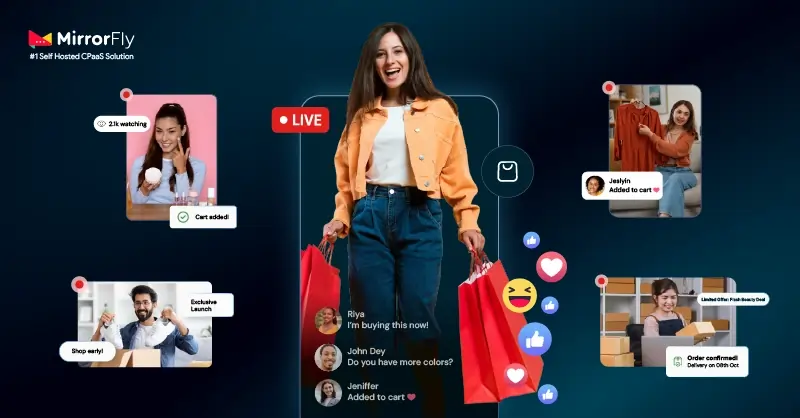
“I’ve explained all you need to know about building a live video shopping app, the development approaches, technologies you need, and recommendations that will help you create a scalable, user-friendly platform the easy way.”
Let’s admit it – Malls are getting crowded. Stores sometimes can’t hold the stocks customers need.
Eventually, people choose to stay on their couches, order the product they like, and get it delivered to their doorstep.
There’s a drawback – static images often fail to provide the clarity they need about the product, leading to more returns and bad reviews.
Solution?
Sellers are switching to live video sessions where a real person demonstrates how a product looks, feels, and works in real-time.
Most of them use Instagram or TikTok live shopping that typically combine the personal touch of in-store shopping with the convenience and reach of online retail.
Now, if you are a business or individual interested in building your own custom live video shopping app, stay with us for the next 10 mins. You’ll get a full picture of how to achieve this, all by yourself!
Table of Contents
What Is A Live Shopping App?
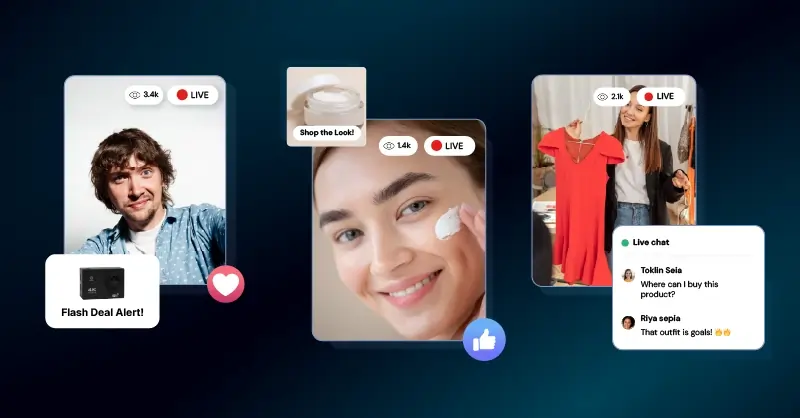
A Live shopping app is an e-commerce platform that enables businesses to showcase their products in real-time video & drive purchases using live video streaming.
A host or seller goes live through the app, presenting products while interacting with viewers via live chat or voice. Viewers can ask questions, see the products in action, and purchase instantly without leaving the stream.
How Live Shopping Apps Work
In the front-end, we know logging into an app, and clicking on the ‘Go Live’ button will take the product to all corners of the earth.
But how does this work? What happens technically?
Here’s a quick walk-through of a live shopping app’s workflow:
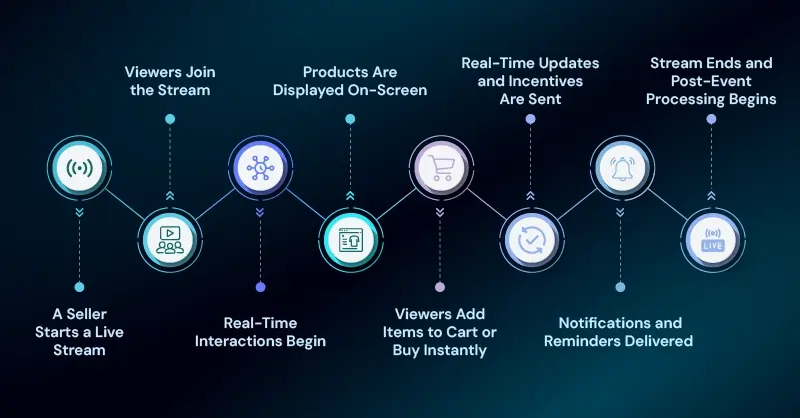
A Seller Starts a Live Stream
The seller or the presenter is the host. If they want to start selling their products online through a video stream, here’s how they can use your app:
- Open your app
- Login to their account
In the backend, the app uses secure authentication methods like OAuth or JWT-based sessions to verify the credentials of the host.
- Credential match the registered users recorded
- Your app lets the seller to access their account
- The seller heads to the streaming options
- Clicks ‘Go Live’
Provided the microphone and camera access are given, the app captures the video and audio from the host’s device and sends it to a media server or cloud streaming service.
This media server receives the video and audio data and transcodes them into different quality levels (like 720p, 480p, etc.)
- Goes Live
By this time, the video stream will be available on the app for viewing.
Viewers Join the Stream
When a viewer wants to watch a stream, they’ll login to the internet shopping app and open the feed.
Right here, the video started by the seller plays.
How?
Once the seller starts the video stream, the transcoded data from the media server reaches the Content Delivery Networks (CDNs)
Why?
Distribution to multiple clients from the same server might delay the streams. CDNs act as an intermediary between the host’s server and the buyer’s device.
They receive the video data, identify the closest server to each viewer and stream the video from them.
Real-Time Interactions Begin
Video shopping apps are not only for product demos and displays. People interact, ask questions and provide feedback as well.
This means, your app needs live chat or emojis. This is where a WebSocket connection on your app uses services like MirrorFly to enable messaging capabilities in real-time.
While the chat is enabled, you can also use the same services to add moderation tools to help filter spam, block inappropriate words, or limit message frequency to avoid overwhelming the host.
Products Are Displayed On-Screen
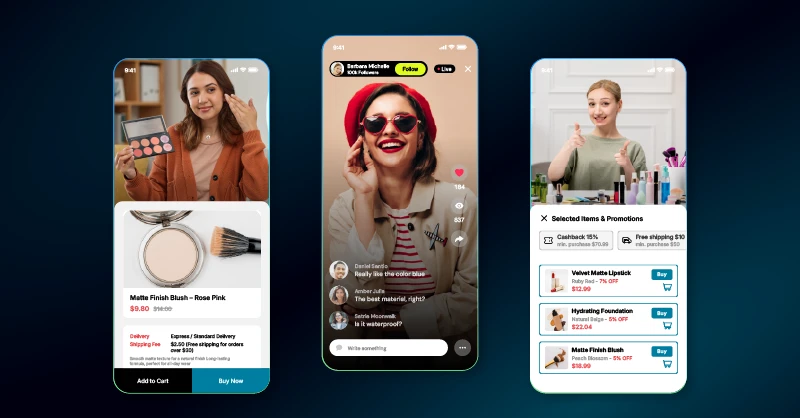
As the stream goes on, with interactions happening, sellers can also use options on your app to show related items on the screen in real-time.
For this, the backend sends a list of products through an API, often pulling from a product catalog or inventory database.
Don’t worry about viewers leaving the stream to explore these related products. Sellers can show these products as overlays on the video, so buyers can check them out on the same screen where the stream is playing.
The frontend, built using tools like React or Vue, updates product info dynamically as the stream progresses.
Viewers Add Items to Cart or Buy Instantly
It’s time to meet the purpose of the stream.
When a viewer wants to buy something, they can tap a Buy Now or Add to Cart button that appears during the stream.
This action sends a request to the backend’s Cart API. Now, this API adds the item to the user’s cart.
When ready to check out, the user completes payment using integrated systems like Stripe, PayPal, or Shopify Checkout.
Finally, a confirmation is shown to the user with an order ID after successful payment.
Real-Time Updates and Incentives Are Sent
Is only a one-time purchase enough?
Not at all!
To keep buyers coming back or retain them as long-term customers, sellers need to keep sending live updates and promotions.
The backend uses push events or WebSockets to send messages like “Only 3 left!”
Sellers can also use countdown timers for flash deals or auctions that are synced with the server to ensure accuracy.
Apart from this, it is also important to engage and encourage buyers with gamification features such as reward points, discount codes, or live bidding.
This naturally gives a satisfied and interactive shopping experience to viewers and keeps them wanting to come back every time a shopping video streams on your app.
Notifications and Reminders Delivered
To increase attendance and return visits, sellers can send out notifications before and after events.
For this, your app will use the backend tasks or serverless functions to schedule push notifications (like “Stream starts in 15 mins”)
Services like Firebase Cloud Messaging (FCM) for Android or Apple Push Notification service (APNs) for iOS take care of delivering these notifications to viewers in real-time.
Stream Ends and Post-Event Processing Begins
A stream is a goldmine of content for sellers. After the live session ends, sellers can access the saved stream on your app and repurpose the stream for future viewing.
The video is saved to cloud storage systems like Amazon S3 or Google Cloud Storage.
It’s converted into a video-on-demand (VOD) format so users can watch the replay later from the product page or a stream archive.
So, that’s how interesting things get cooked at the backend every time a stream happens on your app.
Beyond the tools mentioned in this process, you’ll need a few more technologies so your app can carry out multiple functionalities.
Here’s a quick glimpse into the tools & technologies you’ll need:
| Category | Technologies & Tools |
|---|---|
| Core App Development | iOS, Android, Flutter, React Native, UI/UX Design Tools |
| Frontend Development | React.js / React, Angular.js / Angular, Vue.js |
| Backend Development | Node.js, Express.js, Django, Laravel, Python, Java, .Net / ASP.Net, PHP, CodeIgniter, MEAN Stack |
| Live Streaming Technologies | WebRTC, RTMP, Agora.io, Wowza, Twilio, Jitsi, Zoom, HLS, Nimble Streamer, node-media-server, OBS, Streamlabs |
| Databases & Cloud Storage | MongoDB, Firebase, PostgreSQL, SQL Server, Cassandra, HBase, Datastax, Amazon S3, Google Cloud Storage |
| Cloud & Hosting Services | AWS (Amazon Web Services), Google Cloud Platform, Azure |
| Payment Gateways & Finance | Stripe, PayPal, Square, Braintree, Telr, PayFort, e-Wallets, Escrow Integration, Shopify |
| Real-time Video & Chat | WebSockets, Socket.IO, MirrorFly Video Chat SDK |
| Analytics & Advanced Features | AI Product Recommendations, AR & Virtual Try-Ons, Real-time AI Chat, NFT/Blockchain Integration, IBM, Cisco, Apache Flink, BigData, Spark, Hadoop |
| E-commerce Integrations | Shopify, WooCommerce, Magento, PrestaShop, Wix, Shoplazza, Shopware |
| Other Tools | Google Map, MailChimp Integration, YouTube Live Control Room |
How To Monetize Your Live Shopping App?

You can be a business owner who’ll use the app for selling out your products or a B2B app owner who connects sellers and buyers on your platform.
As a Business, you have options like,
- Selling your products on live sessions as your viewers watch and make purchase
- Sponsor other brands and promote their products during the sessions you go live.
- Earn a commission whenever your viewers use the link you promote in your live sessions to buy products from other businesses.
- Charge users to attend exclusive product demos, tutorials, or premium events.
- Combine complementary products into value packs during live shows for Higher AOV (Average Order Value)
- Get Virtual Tips or Gifts from your Viewers
and a lot more options.
Now, as a B2B app owner, you can
- Take a cut from each sale made on the platform as “Platform Fee”
- Charge sellers for accessing premium features like detailed analytics, no. of viewers, and marketing tools.
- You can dedicate a space on your homepage or during live videos to display ads
- Take a percentage from tips or digital gifts sent by viewers
- Charge for featuring the products with short, catchy and interactive video advertising.
- Like sellers, buyers can also pay for access to premium features or premium content.
These are the most common ways to earn from a live shopping app. But there are other creative ways you can come up with too!
Core Features Of A Winning Live Shopping App
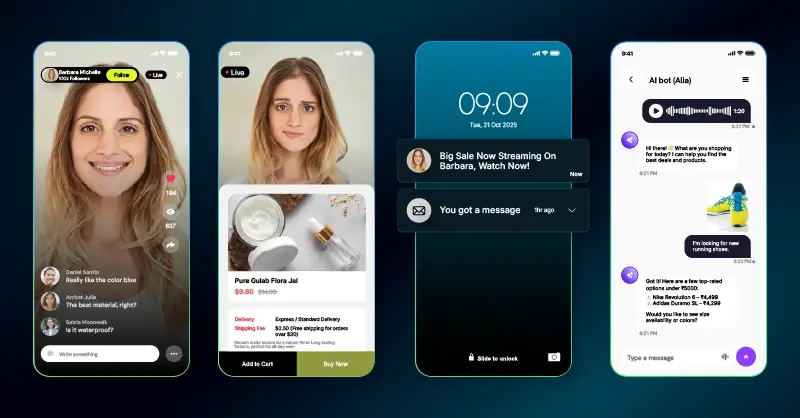
Now that you’re planning to build a live shopping app, let’s look at the features you can add to the app.
1. Live Video Streaming
- This is the heart of a live shopping app. Businesses can host live sessions to give a demo of products.
2. Live Chat & Comments
- Hosts can interact with viewers on live sessions. Viewers can ask questions, react with emojis and have an engaging experience on your app.
3. Bidding & Auctions
- Sellers can start live auctions, use countdown timers or live leaderboards to attract user engagement during the live sessions.
4. Buy Now / Instant Purchase
- Options to buy a product immediately without leaving the stream or viewers can join a bidding war that sellers can schedule for a later time after the stream.
5. Product Listings During Live Shows
- Show a catalog of items with prices, images and availability details, so viewers can buy them during the stream. On the other hand, sellers can tag products so viewers can tap on them to learn more or buy instantly.
6. AR Try-Ons (Augmented Reality)
- This is an advanced feature where viewers can use the “try on” feature to see virtually how a sunglass or a lipstick suits them, using their phone camera, or even a furniture or appliance in their room.
7. Games & Flash Deals
- Add polls, quizzes, giveaways, or timed discounts that encourage impulsive buying, during live sessions.
8. Push Notifications
- Notify or nudge viewers about an ongoing live show, product drops, limited-time deals or even the pending items in their cart.
9. Tips & Virtual Gifts
- Add a gifting or tips options that viewers can click on for making payments to the hosts out of brand loyalty or interest.
10. Voice Agents & AI Bots
- Add AI-powered chatbots or Voice assistants that can take care of the basic queries of customers related to purchases or products.
11. User Profiles & Wallets
- Each user gets a profile where they can save payment info, check their past orders, see how much they have on their wallet.
Seller Features
1. Product Management Tools
- Options to upload product images, add relevant descriptions, pricing details, inventory trackers and sales monitoring.
2. Real-Time Analytics
- In-depth data of buyer behavior on the app including tracking on which stream they watch, how long they stayed on the stream, which product video they are interested in, when did they make purchase, which product pages they visit or link they click on to.
3. Multi-Streaming
- Take video streams to multiple platforms including Facebook, Instagram, YouTube or more. Reach where your audience is and make purchases happen easily.
4. Product Spotlight
- Hosts can highlight specific items during a stream so they stand out to viewers and get more attention.
- Hosts can add a spotlight item during the stream to highlight it and increase the chances of buying.
5. Order Tracking
- Whenever buyers need to track their orders, they can see the complete purchase history on the app.
6. Support for Pre-Recorded Live Shows
- Sellers can use tools like OnTheFly to stream pre-recorded videos as if they were live, using custom broadcasting links (RTMP).
- So these are some common features you’ll need in your app to make shopping experiences more fun and engaging. However, you’ll also need some of the background features to keep the app up and running.
- They include secure payments, cloud storages & databases, social channels integration, and loyalty & rewards.
- We recommend you to add only the features that best suit your business requirements, rather than adding too many of them. It might overwhelm the user or distract them from the actual purpose of your app.
How To Build a Successful Live Shopping App: Step-by-Step Guide
Building a basic app is easy these days. But what about building a platform that’s perfect for your target users?
Especially, as a business that revolves around shopping, people need more fun and engaging elements to trust the platform, enjoy it and make purchases – again and again. A trivial app is not just enough. You’ll need a list of features and functionalities that works for your users front and back.
So how do you build that ‘one app’ for live shopping?
Let’s quickly look into how you can achieve it:
Step 1: You need a clear strategy
You can start building an app right away after watching a tutorial video on the internet. Anyone could do that. But as a business, what makes your app stand out is the purpose and goal on top of which you’ll build your platform.
Study the market, users, and how your platform will operate. Follow your competitors closely. Do what they are missing out on. Pay close attention to what gaps or pain points exist that your app could address.
Be specific about the niche or type of shoppers and sellers your app will serve. This clarity will help guide every decision that follows.
Step 2: Fix on how you’ll earn
This is super-important right at the start. You can’t simply build a platform, invest your time and money, to see nothing in return.
Rather, find out the primary ways you’ll earn from your app. It can be from sales commissions, paid featured listings, or a cut from the buyer subscriptions.
Once you know how you’ll earn, build features and navigations around it. And that will yield results faster than having no idea about how you’ll monetize.
Step 3: Add the features & design
This might sound like a basic step. But honestly, you’ll need to outline your feature set, so you’ll not fall into the trap of adding them all.
We’d recommend you to start with a MVP (Minimum Viable Product) if you do not have an app already, especially startups.
Focus first on essential features such as live video, product listings, instant purchases, and chat. Then go for advanced features like auctions, loyalty programs, or AR previews.
On and off, get feedback from your users and finalize which features you need to keep and which one of them you need to remove.
Step 4: Go creative with UI/UX Design
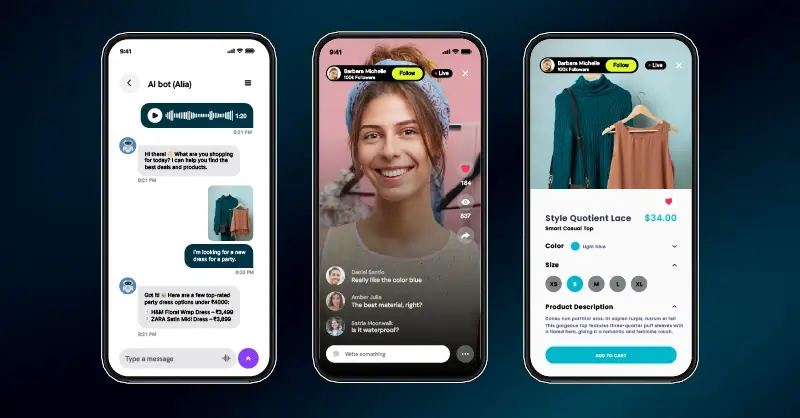
Make users fall in love with your shopping at the first sight.
Start by designing a clean, intuitive app interface. Users should be able to browse live events, view product details, and complete purchases with as few steps as possible.
Rather than going live with all features and basic designs, use mockups and wireframes to lay out the screen flows, design elements, and color schemes.
Have in mind how your users will go around on your app. Imagine yourself as a customer that would like to explore your app. Is it easy to navigate? looks & feels smooth?
This way you can easily polish the app design and significantly impact engagement.
So, our ultimate advice for this phase is – DO NOT RUSH.
Step 5: Choosing the Right Tech Stack
Live shopping platforms are technically demanding, especially when it comes to real-time performance. How will you find which technology works best for you?
Here’s a quick table we think will be helpful for you.
| Component | Recommended Technologies & Tools |
|---|---|
| Frontend (Web) | React.js, Angular.js, Vue.js |
| Frontend (Mobile – Native) | Swift (iOS), Kotlin (Android) |
| Frontend (Mobile – Cross-Platform) | React Native, Flutter |
| Backend | Node.js, Python (Django), Laravel, Java |
| Live Video Protocols | WebRTC, RTMP, Agora.io, Wowza |
| Real-time Chat | In-house development or third-party APIs (e.g., MirrorFly) |
| Databases (Relational) | PostgreSQL, MySQL |
| Databases (NoSQL) | Firebase, MongoDB |
| Cloud Hosting & CDN | AWS, Google Cloud, Microsoft Azure |
Step 6: Development and QA Testing
You might have an app already or you might be building an MVP.
You can use the technologies mentioned in the last step and start building your live shopping app. Or you can just add a pre-built API like MirrorFly to your app or MVP and go live instantly.
We’d recommend you to go for the latter as it is most cost-effective and faster.
All you’ll do is:

Source: https://www.mirrorfly.com/docs/audio-video/android/v2/quick-start/
- Install the SDK in your app
dependencyResolutionManagement {
repositories {
jcenter()
maven {
url "https://repo.mirrorfly.com/release"
}
}
}- Authenticate it using your license. Initialize the solution
ChatManager.initializeSDK("LICENSE_KEY", (isSuccess, throwable, data) -> {
if(isSuccess){
Log.d("TAG", "initializeSDK success ");
}else{
Log.d("TAG", "initializeSDK failed with reason "+data.get("message"));
}
});- Connect to the server
ChatManager.setConnectionListener(new ChatConnectionListener() {
@Override
public void onConnected() {
// Write your success logic here to navigate Profile Page or
// To Start your one-one chat with your friends
}
@Override
public void onDisconnected() {
// Connection disconnected
}
@Override
public void onConnectionFailed(@NonNull FlyException e) {
// Connection Not authorized or Unable to establish connection with server
}
@Override
public void onReconnecting() {
// Automatic reconnection enabled
}
});- Go live
Why is this the smartest approach?
Because, using a pre-built SDK saves so much time, rather than having to spend days and nights on coding and debugging.
Since solutions like MirrorFly & Apphitect are fully customizable, you need not worry about limitations on your app.
You can simply add/ remove any part of the source code, modify it to your requirements and go live on any server you prefer.
Ultimately, the control is all yours – from infrastructure, security and data.
Once the integration is done, test your app on how it behaves, assess the performance when handling high-traffic, do User acceptance testing (UAT), and optimize for smooth video streaming, fast loading times, and minimal latency
It is always advisable to give special attention to video delivery, chat reliability, and cross-platform compatibility.
Step 7: Deployment and Maintenance
After testing is complete, it’s time to deploy your app.
Go for solutions that let you host your platform on your own servers, or any cloud you prefer. Do not get trapped with vendors that impose limitations on where you deploy. This may lead to risks in data control and security.
Once you’ve chosen your deployment, take your app live. Submit it to the Apple App Store and Google Play Store, making sure to meet all requirements for each platform. This process may take a few days depending on review times.
Promote the launch through social media, email campaigns, and influencer partnerships.
Regularly update your app and take care of routine bug fixes, server monitoring, performance checks, and updates to address user feedback. Carry out maintenance activities for app stability while keeping the features fresh and secure.
Overall, by following a clear structure from strategy to launch and maintenance, you increase the chances of building a live video shopping platform that not only functions well but also creates a loyal user base and sustainable revenue.
Key Challenges Of Building A Live Shopping App
Honestly, it’s not easy!
To build, deploy, maintain and monetize – it all takes a lot of effort.
While the road is not smooth, we’d like to give a quick heads-up of what challenges you should be aware of before-hand.
Understand – this list is not to scare you away, rather help you prepare for development hicks, even before they occur in the journey.
1. Stability issues
You’re not just building a shopping app, but a platform that connects users via video. If the connection is slow, sluggish or low-quality, people might abandon your platform. So make sure to use reliable video solutions to deliver a smooth experience, no matter the quality of the user’s network.
2. Tech Complexity
Setting up a shopping platform is like virtually building a super-big mall. You’re going to have thousands to millions of users, watching, exploring or shopping on your app at the same time.
Building such an infrastructure with smooth features and perfect performance is not an easy joke. But if there’s a solution to think about – it’s easy-to-integrate video APIs that make the game all yours.
3. Scalability
Yes, your app is going to expand to hundreds, thousands and millions one day. The numbers will keep going up as your business expands. The question is – Is your app ready to scale without issues in performance and speed?
These growth scenarios demand backend systems that can process data in real time without delays.
This also means implementing quick reconnect workflows if users or hosts lose connection temporarily.
In addition, your streaming platform will also need to transcode video into multiple formats for playback across different devices and bandwidths.
This is where your app will need significant storage and processing power – it’s quite expensive, especially if large volumes of video are being saved and delivered regularly.
4. Integration of Interactive Video Shopping Features
You need your app to be feature-rich. And that might introduce additional complexity during and after your live shopping platform development.
Features such as real-time chat, clickable product cards, and instant purchase options need to work seamlessly alongside your live videos without overwhelming the users or causing lags in loading your app pages.
Adding other omnichannel shopping features like in-app voice assistance or product recommendations based on viewer behavior tracking can enhance the experience but also increases development complexity.
Managing live chat overlays is another challenge. While comments and emoji reactions are important for engagement, they can also distract the host or overload the screen.
So you need to make sure that you plan and place them all without letting the features overlap – it might look & feel clumsy.
5. Security and Data Management
A shopping app involves too many people, products, purchases, and payments.
This means, it’s a lot of valuable data and attackers will come for it anytime.
So beware, protect user data, secure payment processes, and prevent fraudulent activity. While it all sounds simpler, building such a security infrastructure involves strong encryption layers + robust industry compliances.
While you build such a secure fence around your platform, you’ll also need to invest in internal privacy features like reporting, banning, blocking. If you can extend a bit, go for AI moderation that can filter out people or conversations that do not align with the integrity of your business.
6. Cross-Platform Compatibility and Development
Live shopping apps typically need to support multiple platforms including iOS, Android, and web browsers, as well as different device types like smartphones, tablets, and laptops.
Building connectors for each platform and ensuring consistent performance across them requires careful planning and additional development effort.
In many scenarios, Platform-specific issues often arise during testing.
For example, iOS devices do not support Flash video formats, which forces developers to use HLS instead. iOS may also mute videos by default, requiring extra steps such as prompts or tap-to-unmute features, which need to be added into the design.
7. Operational and Preparatory Challenges
Apart from technical development, there are also operational difficulties that impact the experience of hosts and sellers.
Each live session typically requires manual preparation, such as uploading new product listings, updating prices, or configuring promotional settings.
Without clear automation, this becomes repetitive and time-consuming for regular streamers.
Live streams can also encounter technical issues, and there needs to be a plan in place for these situations.
Hosts may need standby visuals, backup products, or technical staff on hand to troubleshoot issues in real time. Without this, even minor problems can disrupt a broadcast and negatively impact user trust.
In summary, developing a live selling app involves far more than standard mobile or e-commerce development. You’ll need a combination of solid architecture, experienced developers, thoughtful UI design, and strong operational planning to address these issues effectively.
Alternatively, you can hand it all over to trustworthy experts, sit back and relax until they build and deliver a fully customizable, secure and feature-rich live video shopping app to you.
Ready-made Apps vs. Own Custom Developed Apps
Like we discussed in the above sections, there are 2 different development approaches.
- You can use an existing platform or
- Build a custom live shopping app yourself
Each path offers its own set of benefits and trade-offs depending on budget, timeline, and long-term business goals.
Choosing the Right Approach
For early-stage startups or brands with limited budgets, third-party platforms or social media integrations are a fast, low-risk way to experiment with live selling.
These tools allow companies to test interest and gather data before investing in full-scale development.
For mid-size to large businesses with long-term ambitions, brand differentiation goals, and a need for full control over user experience and data, custom live ecommerce app development is often the better path.
With partners like MirrorFly, businesses can gain powerful real-time features, robust security, and complete ownership of the platform without starting from scratch.
The decision ultimately comes down to your business model, budget, target audience, and the level of flexibility and ownership you require.
Build Your Own Live Shopping App With MirrorFly
Ultimately, it all narrows down to what you exactly want for your live video shopping app. You can have an app already or plan to build one – for any approach you can rely on solutions like MirrorFly.
MirrorFly is a communication SDK and API provider ideal for building custom chat, voice, and video functionalities into live selling platforms.
This white-label solution offers your development process the following perks:
- 100% Customizable Features and Workflow: Developers can build video communication tools that align perfectly with the platform’s unique needs.
- Full Data Ownership: You maintain complete control over user and interaction data.
- Custom Security Architecture: MirrorFly supports advanced security protocols for compliance and fraud protection.
- Flexible Hosting Options: You can choose between on-premise or cloud deployment depending on your infrastructure needs.
- SIP/VoIP Integration: Ideal for apps that require voice call capabilities or need to integrate with telecom networks.
- Whitelabel Solutions: Fully brandable with your company’s look and feel.
- Hire Dedicated Team: MirrorFly provides dedicated developer teams to support implementation and ongoing support.
- Full Source Code Ownership: You receive complete access and control over the codebase, allowing you to scale and evolve the app freely.
- AI-Powered Capabilities: From chatbots to smart recommendations, MirrorFly enables AI-driven engagement and automation.
These features make MirrorFly an ideal partner for companies looking to embed real-time communication tools within a custom live video commerce platform.
This is just the tip of the iceberg. MirrorFly comes with many more powerful features and benefits. You can explore more on the official website for MirrorFly video call solution or contact experts from the team to discuss how exactly the solution can help your live video shopping app.
I believe this article has given you a clear understanding of the pros and cons of ready-made platforms versus custom-built apps, along with insights into how MirrorFly can fit into your strategy.
Enjoyed this read? Tell us in the comments what you’d like us to explore next.
Ready To Build Your Own Live Shopping App?
Get our enterprise-grade live video shopping solution designed to engage customers and boost sales in real time.
Request Demo100% customizable
White-label solution
Full source code

Related Articles
How To Build A Dating App In 5 Easy Steps
How To Build A Practo-like Healthcare Video Chat App
How to Create an App Like TikTok in 8 Easy Steps
How Does Live Streaming Platforms Work?
How To Build A Live Streaming App In Flutter (13 Steps)